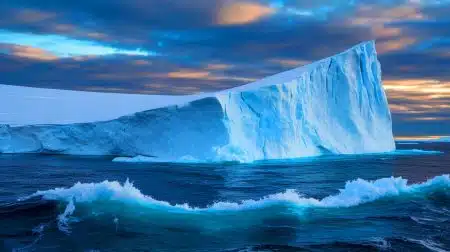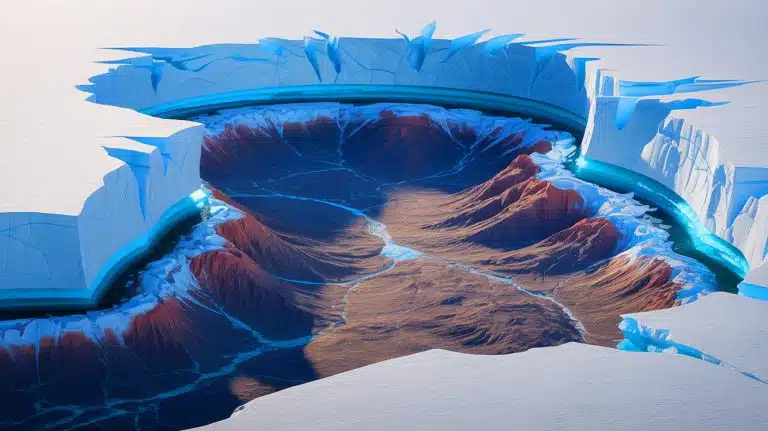| IN A NUTSHELL |
|
Antarctica, often perceived as a vast, frozen wasteland, conceals an astonishing secret beneath its thick ice cover: an ancient and rugged landscape that is just beginning to unveil its geological history. This hidden world, characterized by its dramatic topography, offers significant insights into the continent’s dynamic past. Recent scientific endeavors have focused on the Transantarctic Mountains, a formidable range dividing East and West Antarctica. These studies, led by experts like Timothy Paulsen and Jeff Benowitz, are not only reshaping our understanding of Antarctica but also shedding light on the forces that have sculpted our planet over millions of years.
Exploring Under-Ice Bedrock
The intricate landscape concealed beneath Antarctica’s ice has long intrigued scientists. At the heart of this mystery lies the bedrock of the Transantarctic Mountains, a geological marvel with a history spanning hundreds of millions of years. This bedrock serves as a crucial geological divide, separating the stable East Antarctic craton from the more volatile West Antarctic Rift System. Recent studies suggest a more active geological past than previously assumed, involving cycles of mountain formation, uplift, and erosion. These processes are linked to significant shifts in Earth’s tectonic plates and periods of past glaciation.
To unlock the secrets of this hidden bedrock, researchers analyzed mineral grains in igneous rocks from the Transantarctic Mountains. As Jeff Benowitz explained, the Antarctic ice sheets obscure the bedrock geology, yet the time-temperature evolution of these rocks provides essential clues to understanding the development of Antarctica’s under-ice topography. This research highlights how ancient landscapes, preceding the rise of the Transantarctic Mountains, could have influenced glacial cycles.
Punctuated Mountain Building
In their quest to decode Antarctica’s geological past, scientists have uncovered evidence of intermittent mountain-building phases and subsequent erosion events in the Transantarctic Mountain basement rocks. These findings suggest that the mountain range has undergone several cycles of formation and erosion over geological time. Timothy Paulsen highlights that these events align with major plate tectonic changes along Antarctica’s margins and support a significant glacial period around 300 million years ago.
The study reveals how the continent’s topography has been shaped by uplift, erosion, and ancient glaciations, which may have influenced later ice sheet cycles. Additionally, recent research points to a hidden mountain range buried beneath the East Antarctic ice sheet, formed over 500 million years ago. This discovery further underscores the dynamic geological history of Antarctica, challenging past assumptions and opening new avenues for exploration.
Decoding Ancient Tectonic History
The findings from these studies offer valuable insights into the ancient tectonic history of Antarctica and the evolution of continents over vast geological timescales. By understanding the processes that have shaped this icy continent, scientists can better comprehend the forces driving Earth’s geological changes. The research, published in the journal Earth and Planetary Science Letters, underscores the importance of interdisciplinary collaboration in unraveling the mysteries of our planet’s past.
As scientists continue to probe the depths of Antarctica’s ice-covered landscapes, they are piecing together a complex geological puzzle that has implications for understanding global tectonic processes. The Transantarctic Mountains, once considered a static feature, now reveal a dynamic history of formation and transformation, offering a window into the Earth’s ancient past and its ongoing geological evolution.
The Future of Antarctic Research
As we delve deeper into the mysteries of Antarctica, it becomes evident that this frozen continent holds the key to understanding Earth’s geological history. The work of dedicated scientists like Timothy Paulsen and Jeff Benowitz is paving the way for future research, as they continue to explore the hidden landscapes beneath the ice. These findings not only enhance our knowledge of Antarctica but also contribute to a broader understanding of how continents evolve over time.
As new technologies and methodologies emerge, the potential for uncovering further secrets beneath the ice is vast. What other hidden landscapes might await discovery? How will these revelations reshape our understanding of Earth’s geological past and its future? The journey to unlock Antarctica’s secrets is just beginning, and the implications for science and humanity are profound. How will our evolving understanding of this icy frontier influence our approach to studying and preserving the planet’s geological heritage?
Did you like it? 4.6/5 (20)






Amazing discovery! I had no idea there were mountains hidden under the ice. Nature never ceases to amaze me. 🌍
Fascinating read! I wonder what other secrets are hidden under the ice. ❄️
How much of Antarctica’s bedrock remains unexplored, and what are the biggest challenges in studying it?
Does this mean that Antarctica is geologically more active than we thought?
This is just the tip of the iceberg, literally and figuratively! 😂
Wow, this really changes how I think about Antarctica. Thanks for the enlightenment!
I’ve always been curious about how scientists conduct research in such extreme conditions. Any insights?
Is it possible that these mountains could have once been above sea level?
The article mentions tectonic shifts. Are these still happening today in Antarctica?
Do these discoveries have any implications for the understanding of past glaciations?
With all these discoveries, could Antarctica hold clues to the future of our planet?
This sounds like a plot from a sci-fi movie! 🌌
This is fascinating, but how do they actually study these mountains if they’re buried under all that ice?
I’d love to see some visuals or diagrams of what these hidden mountains might look like.
What’s the potential impact of these findings on global geology studies?
Is there any evidence of volcanic activity related to these mountain formations?
I had no idea about the Transantarctic Mountains before reading this. Thanks for the info!
How do these discoveries affect our understanding of global ice sheet dynamics?
Can this research help predict future geological changes on Earth?
Do they plan on drilling into these mountains to gather more information?
What techniques do scientists use to map such inaccessible areas?
The idea of hidden mountain ranges is mind-blowing. What else don’t we know about our planet? 🤯
How reliable are the methods used to date these geological formations?
Is there any collaboration with other countries on this research?
What kind of technology is used to study these buried landscapes?
Just when we think we know everything about Earth, something like this pops up!
Thank you for this detailed article. It’s fascinating to learn about Earth’s “lost” features.
Could this change the way we view continental drift and tectonic theory?
What are the implications of these discoveries for understanding the history of global sea levels?
Thank you for sharing this incredible research! It really opens up a new perspective on Antarctica. 😊
Do they expect to find similar geological features in other icy regions of the world?
So, does this mean that Antarctica wasn’t always covered in ice? What was it like before?
Could these findings affect our understanding of climate change? 🧊
I’m skeptical. How can they be sure about the history of rocks buried under miles of ice?
Great article! But what practical implications do these discoveries have for the rest of us?
Are there any resources available for further reading on this topic? 📚
Did they find any signs of ancient life in these mountain ranges?